(originally posted November 17, 2010)

Ever wondered what it looks like above Barndiva? Here's your chance. Great images and recipes by Chef Ryan accompany the article by Sarah Lynch in California Home + Design Magazine.
Raising the Barn: An International Aesthetic Meets the Best of Wine Country's Heartland
Photo credit:
Photography by Drew Kelly and Brad Gillette

LEFT: Studio Barndiva’s eclectic offerings include local artwork and imported accessories, but the blue fireplace—adorned with a Magritte-worthy “It is not a fireplace”—makes it clear that visitors can always expect a surprise. TOP RIGHT: Jil and Geoffrey Hales built their barn (right) from scratch.
The perfect evening out brings together three elements: a delicious meal, a warm atmosphere and lively conversation. For Jil Hales, the proprietor of Healdsburg’s Barndiva restaurant, the bar is set significantly higher because the bar is where it all began.
“We came to Healdsburg eight years ago, after raising our kids in the U.K. and living in San Francisco for a few years,” says Hales, a Los Angeles native married to Geoffrey, a Brit, who brought his hardwood flooring company to the U.S. “What this town was missing was a world-class bar—a place to get a cocktail and a bite to eat late at night.”

LEFT: The kitchen island in the pied-à-terre was fitted with fluorescent lighting and colored gels as a prototype for the restaurant bar. RIGHT: A farm-worthy monitor, painted salmon pink, in the center of the ceiling will one day be accessed by a catwalk.
While the Hales were dividing their time between London and a fruit farm in Anderson Valley that Jil has owned for 30 years, they bought a property just off the town square in Healdsburg and built a two-story barn from the ground up. Downstairs, the bar and restaurant serve the best cocktails in town and an ever-evolving menu of farm-to-table dishes. Upstairs is the Hales’ pied-à-terre. Acting as general contractor and chief designer of the barn was an all-encompassing project, and Jil lived up to the nickname her friends had given her when she first moved to Anderson Valley: the Barn Diva.
Adapting the name to her new venture, Jil’s restaurant suitably hits a few high notes. From the outside, the building suggests a familiar rural vernacular—it’s a single structure with richly stained board-and-batten siding. Inside, the towering space is a sophisticated mix of travertine floors, wood tables, a colorfully lit bar and cream-colored walls adorned with modern art and antique farming tools. Out back, an enclosed garden is set with tables, big rustic sculptures and a trickling water feature; overhead mulberry trees are draped with twinkling fairy lights and a heritage black walnut offers dappled shade during the day.

FROM LEFT: The Cor-Ten steel and neon lights in Barndiva’s sign hint at the owners’ modern sensibilities; Studio Barndiva represents local artists such as painter Laura Parker and wire sculptor Ismael Sanchez; floor-to-ceiling drapes, formal flower arrangements and streamlined drum shades are just some of the sophisticated designs Jil chose for the restaurant; before coming to Barndiva
The pied-à-terre upstairs, which is accessed through the front door tucked alongside the restaurant’s entry patio and up a Dan Flavin-esque staircase with rainbow fluorescent risers, is even more of a surprise. It feels like a loft in Tribeca rather than a barn apartment in Sonoma County. The voluminous main room is centered on an oval dining table surrounded by red leather Eames Executive chairs. On one side a 16-foot-long kitchen island is topped with another fluorescent-lit bar (the prototype for the bar downstairs). The kitchen itself is an updated take on the European unfitted kitchen, with open storage, several sinks and a formidable black-enamel Lacanche range. A built-in bar adorned with Jil’s favored Tunisian ironwork, more classic midcentury furniture and artwork collected from around the world complete the scene in the main space. On one end is a guest bedroom and office mezzanine, and on the other is a master suite.
Two-and-a-half years after completing the barn, the restaurant was bustling on evenings and weekends, and Jil was ready to raise the bar even higher. The Hales’ life in Healdsburg had become increasingly focused on the community around them as they supported local vintners and farmers. But Jil’s passion for art and design needed an outlet, and the four walls of the restaurant were filled. So in 2007 she opened a gallery next door in a space that was formerly an opera house. Artists & Farmers, as it was originally called (now Studio Barndiva), was a place to celebrate and sell the art and designs she discovered locally or on her many travels. On display is an assemblage of Hales’ own lighting made from Tunisian architectural salvage along with locally crafted paintings, wire sculptures, blown glass, reclaimed wood furniture, imported gifts and accessories. “I don’t want to show things that can be easily found somewhere else,” says Hales, pointing out one exception: aselection of John Derian back-painted glass plates. “I know he’s in lots of other shops, but he’s a friend.”

LEFT TO RIGHT: The restaurant’s back patio features pendants that Jil fashioned from Tunisian window guards; fluorescent lights show up at the bar, where a circular backlit inset mimics the two round windows at the top of the building; the entrance to the private residence is marked by a dramatic glowing staircase; the weather in Healdsburg makes it ideal for outdoor wedding receptions.
Behind the gallery is yet another garden. This one is filled with raised vegetable beds, outdoor sculpture and a table large enough to seat 200 under an armature designed for a canopy of mini-globe lights. Like the garden on the other side of the fence, the setup begs for a modern country wedding and it’s been a popular spot for such events since it opened. In fact, Geoffrey and the couple’s eldest son, Lukka, run Barndiva’s event and hospitality business, and they’re now averaging 60 weddings a year. The Hales have also taken over management of the nearby Healdsburg Modern Cottages, four nightly cottages authentically furnished with pieces by Eileen Gray, George Nelson, and Ray and Charles Eames.

LEFT: The humble facade of Barndiva belies the stylish elegance of the experience inside. RIGHT: An outdoor area behind the gallery is attached to the restaurant’s garden through a gate and is a popular spot for wedding receptions.
In her mission to open a world-class bar in this sleepy town, Jil has elevated the creation of the perfect evening to an art form. “I went for the type of environment where I would want to share a meal or toast a special occasion with friends,” she says. “If something doesn’t come from the heart, it just doesn’t work. If you’re not authentic, you’re running on fumes.”
Sitting under twinkling lights, as a parade of seasonal dishes made by Thomas Keller–trained chef Ryan Fancher, original cocktails and wine selected by the in-house sommelier passes by, it would be hard to argue against that.

Recipes from Barndiva’s Chef Ryan Fancher
Both of these recipes make the most of fruit and vegetables in late summer or early autumn, when ingredients are at the height of their season. They are great dishes to source at a local farmers market.

Barndiva’s Heirloom Tomato & Compressed Watermelon Salad
Serves 4
1 medium watermelon
1 tsp. lemon verbena
1 large golden beet
1 large Detroit dark-red beet
6 heirloom tomatoes
2 Tbsp. sweet basil
4 Tbsp. Spanish sherry vinaigrette
Salt and freshly ground pepper
1 cup purslane (optional)
2 Tbsp. crystallized ginger, diced
2 red radishes
Spanish Sherry Vinaigrette
1 cup grape seed oil
1/3 cup Spanish sherry vinegar
A pinch of salt, sugar and freshly ground pepper
• The Watermelon - The night before or a few hours before serving, cut into large cubes and sprinkle with the chopped lemon verbena. Wrap tightly in plastic wrap and refrigerate.
• The Beets - Cover with 2 cups water, 1 Tbsp. butter, 1 clove garlic and a sprig of thyme. Cover and cook at 350° for 3 hours. Cool and slice.
• The Heirloom Tomatoes - Slice them thickly and mix them in with the chopped sweet basil. In a bowl, whisk together all of the ingredients for the vinaigrette. Bathe the tomatoes in 4 tablespoons of the vinaigrette for 30 minutes or more. Season with salt and freshly ground pepper.
• Assemble - Stack the tomatoes, largest one on the bottom. Arrange the watermelon. Dress the beets in the bathing vinaigrette, season with salt and pepper, and plate. Sprinkle ginger and thinly sliced radishes over the dish. Dress the purslane, and add it to the dish to finish.

Herb-Roasted Local Halibut
Serves 4
8 baby artichokes
2 Tbsp. canola oil
4 cloves garlic
2 springs rosemary
Salt and pepper
20 fava beans
1 zucchini
1 gold bar squash
5 lbs. Roma tomatoes
15 Toy Box cherry tomatoes
2 Tbsp. extra virgin olive oil
4 6-oz. halibut filets
1 Tbsp. butter
1 cup tempura batter
4 squash blossoms
Tempura batter
1/2 cup flour
Corn starch
1 tsp. baking powder
1/2 cup sparkling water
Salt
• The Baby Artichokes - Peel the outside layers to reveal the heart. In a hot pan, roast the artichokes with canola oil, garlic and rosemary until soft. Season with salt and pepper.
• The Fava Beans - Peel the favas, and cook them in boiling salted water for one minute. Let cool.
• The Summer Squash - Cut the zucchini and squash into diamond shapes, and cook them just like the fava beans.
• Vierge sauce - Puree the tomatoes, and strain the clear liquid from the tomatoes through a clean kitchen towel. In a saucepan over medium heat, reduce the liquid by half, and season with salt and pepper. Drizzle extra virgin olive oil.
• Halibut - In a hot sauté pan, sear the fish until golden brown, being careful to not overcook. Baste with butter, garlic and rosemary.
• Assemble - Pool the sauce in a bowl or shallow plate. Arrange the vegetables in the sauce, and nestle the halibut in the middle. In a bowl, mix the tempura batter’s ingredients, and dress the blossom lightly with the tempura batter. Fry in 350° oil until golden, and place on top of fish.
By Sarah Lynch on October 04, 2010 at 3:13 PM
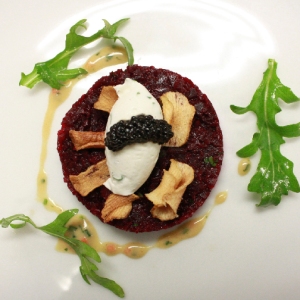 The dish we paired with The Fighter was meant to be raw and bloody ~ though the ‘blood’ came from a vibrant beet tartar whose magnificent color was spiked with a bit of vinegar. It was topped with a moussaline of whipped crème fraîche, a dollop of caviar, and a wreath of baby sunchoke chips. Texturally, while the beets and sunchoke chips initially tasted very different, the earthy flavor profiles of both root vegetables played in concert when paired with the creamy moussaline and salty caviar.
The dish we paired with The Fighter was meant to be raw and bloody ~ though the ‘blood’ came from a vibrant beet tartar whose magnificent color was spiked with a bit of vinegar. It was topped with a moussaline of whipped crème fraîche, a dollop of caviar, and a wreath of baby sunchoke chips. Texturally, while the beets and sunchoke chips initially tasted very different, the earthy flavor profiles of both root vegetables played in concert when paired with the creamy moussaline and salty caviar.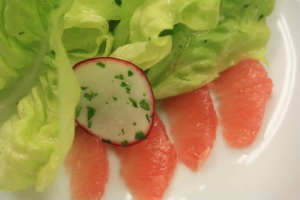 The idea behind serving a spare green salad to honor a movie about starving ballerinas started as a joke. Then Chef saw Black Swan and was actually incredible moved by Natalie Portman’s beauty and elegance. With it’s ruffle of butter lettuce, sharp crimson edge of radish, and delicate segments of ruby red grapefruit, the salad, finished with champagne vinaigrette and a shower of flowering rapini, was indeed a visual ballet of color and form. Delicious as well.
The idea behind serving a spare green salad to honor a movie about starving ballerinas started as a joke. Then Chef saw Black Swan and was actually incredible moved by Natalie Portman’s beauty and elegance. With it’s ruffle of butter lettuce, sharp crimson edge of radish, and delicate segments of ruby red grapefruit, the salad, finished with champagne vinaigrette and a shower of flowering rapini, was indeed a visual ballet of color and form. Delicious as well.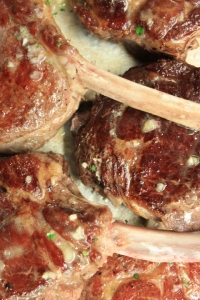 Back in the day, when people still cooked on the hearth, small town bakeries were often used by villagers to cook their evening meal in the still warm wood fired ovens once the bread run was finished. There wasn’t a lot of heat left and space was always at a premium ~ but I’m guessing some wonderful rustic recipes came out of this unique and very communal way of cooking. The story behind Boulangère potatoes was simple: meats were put on the top shelf with sliced potatoes beneath them, the better to catch the delicious meat drippings.
Back in the day, when people still cooked on the hearth, small town bakeries were often used by villagers to cook their evening meal in the still warm wood fired ovens once the bread run was finished. There wasn’t a lot of heat left and space was always at a premium ~ but I’m guessing some wonderful rustic recipes came out of this unique and very communal way of cooking. The story behind Boulangère potatoes was simple: meats were put on the top shelf with sliced potatoes beneath them, the better to catch the delicious meat drippings.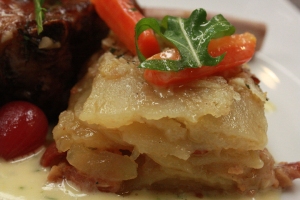 Ryan’s homage to the dish couldn’t involve a bread oven. But if you took your eyes away from the screen on Oscar night and closed them, it was easy to taste the inspiration. His savory layer cake of thinly shaved potatoes was saturated in dark stock that dripped down flavoring the potatoes during the baking process. Served alongside big juicy veal chops from milk and grass-fed free range calves, this was haute campfire with True Grit. The veal was sourced from Sonoma Direct, where Ritz Guggiana and his cookbook-writing daughter Marissa (Primal Cuts) find some of the most delicious ethically sustainable animals in the county.
Ryan’s homage to the dish couldn’t involve a bread oven. But if you took your eyes away from the screen on Oscar night and closed them, it was easy to taste the inspiration. His savory layer cake of thinly shaved potatoes was saturated in dark stock that dripped down flavoring the potatoes during the baking process. Served alongside big juicy veal chops from milk and grass-fed free range calves, this was haute campfire with True Grit. The veal was sourced from Sonoma Direct, where Ritz Guggiana and his cookbook-writing daughter Marissa (Primal Cuts) find some of the most delicious ethically sustainable animals in the county.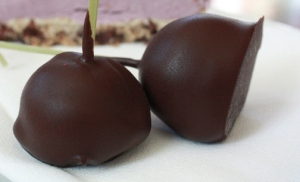 Opps. While the Journal’s photographer clearly remembers devouring the Toy Story 3 Bon Bon course just as Best Picture was announced, images of it clearly did not make it into the camera. The plate was a riot of color ~ with sprinkles, roasted coconut and almond flakes covering dark, milk and white chocolate Bon Bons filled with passion fruit, vanilla and crème fraîche ice cream. The good news is that the Bon Bons above are equally delicious and better yet, available often on our regular dessert menu.
Opps. While the Journal’s photographer clearly remembers devouring the Toy Story 3 Bon Bon course just as Best Picture was announced, images of it clearly did not make it into the camera. The plate was a riot of color ~ with sprinkles, roasted coconut and almond flakes covering dark, milk and white chocolate Bon Bons filled with passion fruit, vanilla and crème fraîche ice cream. The good news is that the Bon Bons above are equally delicious and better yet, available often on our regular dessert menu.


































